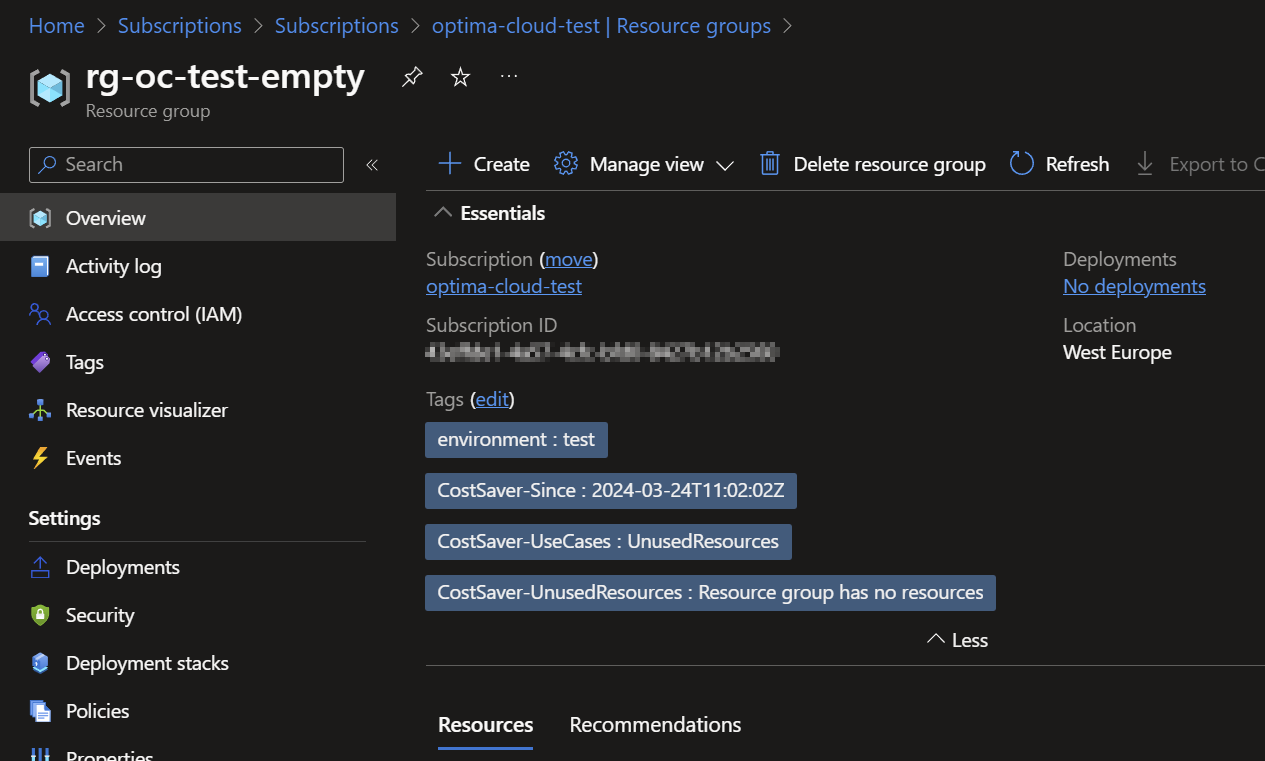Tagging
BKB Cloud can place tags on identified resources, tagging them with the type of use case that detected optimization opportunity.
 Tags on empty resource group.
Tags on empty resource group.
Pros of tagging
Because we believe that you might not want to place our tags across your resources, there are a few reasons why it could be a good thing.
This claim is based on real scenarios that we observed to our customers.
When we identify cost-saving opportunities, it will take structured approach to start remediating those findings.
Let's consider the following example: BKB Cloud detected storage account that is not being used for over 6 months.
- Even when the storage account is not being used for such a long time it will be impossible choice for Azure/DevOps Engineer to just go ahead and delete it
- Especially if the storage account isn't entirely empty, it will require deeper investigation
- Usually, person tasked with the deletion will have to find the owner and get approval for deletion or some reason why is the storage account in this state
- This can be relatively complicated process, not for each resource, but there will be some that require several emails to be sent and involvement of more than one person
Resources like this can be forgotten resources, just not deleted after fulfilling the purpose. The problem is, when a different person (different than the one who has created it) is tasked with deletion. Because the person doesn't know anything about the resource, it will require searching for the answer whether it is truly unused or if it’s just not being used right now.
The ones who know the most about resources are those who have created them.
For most of the larger companies having large footprint in Azure, it is safe to say that there will be hundreds of employees accessing the Azure and browsing one or more resources in the portal, via terraform plan, via CLI or through some deployment pipeline - such as Azure Devops pipeline.
With the correctly placed tags that are conveying the intent in a clear way, it is possible that the person who has created the unused resource will notice it. It might be enough if the person sees it and decides to delete it in matter of minutes, instead of starting an investigation.
Tagging will not resolve all issues overnight, but it is the "little help" that your company can get to speed things up. It will help to bring your employees to a higher consciousness by letting them know that there is something out there that has noticed some sub-optimal usage.
Idempotent and non-invasive
Tags are idempotent, meaning if resource is being unused for one year, it will not change any of the tags it has placed. If the tags are deleted (either manually or via some IAC such as Terraform), application will place those tags again.
Tags are also non-invasive, meaning that we will not change any of the tags that you already have.
Content and configuration of the tags
Configuration
Tagging can be enabled or disabled (disabled by default).
The default prefix CostSaver- is configurable.
Content
Below are the tag keys and example values.
Since
Date and time since when the resource is identified.
Key CostSaver-Since Value 2024-03-27T00:26:00Z
UseCases
Use case name/s (comma separated if multiple use cases) that identify the resource for optimizations.
Key CostSaver-UseCases Value UnusedResources
Description
Use case text further explaining why it is being identified by the use case.
Key CostSaver-{Use Case Name} Value Storage account is empty